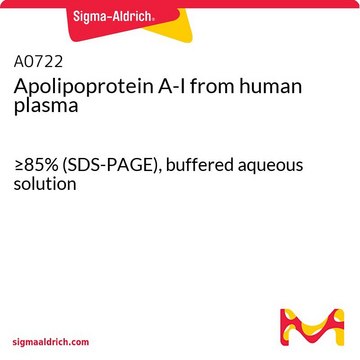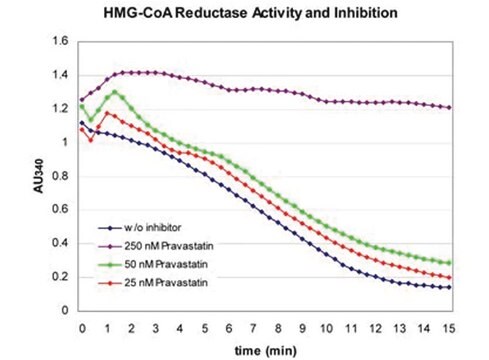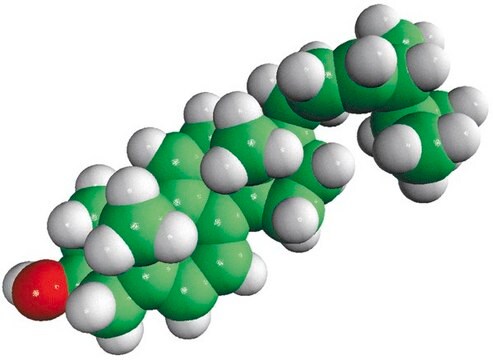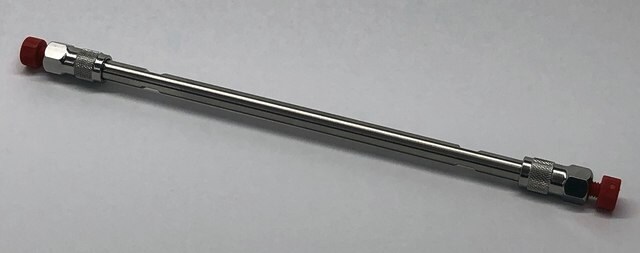A7910
Apolipoprotein C-II from human plasma
≥95% (SDS-PAGE)
Faça loginpara ver os preços organizacionais e de contrato
About This Item
Produtos recomendados
fonte biológica
human
Nível de qualidade
Ensaio
≥95% (SDS-PAGE)
Formulário
powder
peso molecular
average mol wt 8.8 kDa
técnica(s)
ligand binding assay: suitable
nº de adesão UniProt
temperatura de armazenamento
−20°C
Informações sobre genes
human ... APOC2(344)
Descrição geral
Apolipoprotein C-II (APOC2/apoC-II), a small exchangeable apolipoprotein, is expressed in the liver and secreted into plasma. It is present on the triglyceride-rich lipoproteins (TRL), like chylomicrons (CM) and very-low-density lipoproteins (VLDL), and high-density lipoproteins (HDL), mainly during fasting. The intestine, macrophages, adipose tissue, brain, skin, lungs, retina, and retinal pigment epithelium are among the tissues that produce ApoC-II.
Aplicação
Apolipoprotein C-II activates lipoprotein lipase and has been used in a study to assess HDL proteome in hemodialysis patients. An excess of apolipoprotein C-II is associated with increased triglyceride-rich particles and alterations in HDL particle distribution.
Ações bioquímicas/fisiológicas
Activates lipoprotein lipase
Apolipoprotein C2 (APOC2) serves as an activator of lipoprotein lipase. It is involved in the hydrolysis of triglycerides (TG) on TG-rich lipoproteins (TRL) to release free fatty acids (FA). Higher expression of APOC2 is observed in patient-derived glioblastoma stem cells, hypopharyngeal cancer, invasive ductal breast cancer, clear cell renal cell carcinoma, gastric cancer, centroblastic lymphoma, early-stage colorectal tumor, and skin squamous cell carcinoma. ApoC-2 is considered as a new sensitive biomarker for diagnosing Takayasu arteritis (TAK).
Código de classe de armazenamento
11 - Combustible Solids
Classe de risco de água (WGK)
WGK 3
Ponto de fulgor (°F)
Not applicable
Ponto de fulgor (°C)
Not applicable
Escolha uma das versões mais recentes:
Já possui este produto?
Encontre a documentação dos produtos que você adquiriu recentemente na biblioteca de documentos.
Anastazia A Kei et al.
Metabolism: clinical and experimental, 61(7), 906-921 (2012-02-07)
The focus of this review is on the role of apolipoprotein C-II (apoC-II) in lipoprotein metabolism and the potential effects on the risk of cardiovascular disease (CVD). We searched PubMed/Scopus for articles regarding apoC-II and its role in lipoprotein metabolism
Vishnu Swarup et al.
Neuroscience research, 73(2), 161-167 (2012-03-20)
Spinocerebellar ataxia 12 (SCA12) is a unique dominant type of ataxia characterized by early and prominent action tremors, memory deficit, neuropathy, dysarthria, etc. The expansion of DNA triplet (CAG) repeats in 5'UTR of PPP2R2B gene appears to be the cause
Alain Mangé et al.
PloS one, 7(3), e34107-e34107 (2012-04-04)
Aside from a decrease in the high-density lipoprotein (HDL) cholesterol levels, qualitative abnormalities of HDL can contribute to an increase in cardiovascular (CV) risk in end-stage renal disease (ESRD) patients undergoing chronic hemodialysis (HD). Dysfunctional HDL leads to an alteration
Deregulation of apolipoprotein C2 gene in cancer: A potential metabolic vulnerability.
Yuqiao Liu et al.
Clinical and translational medicine, 11(6), e406-e406 (2021-06-30)
Anna Wolska et al.
Atherosclerosis, 267, 49-60 (2017-11-04)
Apolipoprotein C-II (apoC-II) is a small exchangeable apolipoprotein found on triglyceride-rich lipoproteins (TRL), such as chylomicrons (CM) and very low-density lipoproteins (VLDL), and on high-density lipoproteins (HDL), particularly during fasting. ApoC-II plays a critical role in TRL metabolism by acting
Artigos
Since cholesterol is a water-insoluble molecule it must be packaged for transport within the plasma. The particles that package cholesterol, cholesteryl esters, and triglycerides for transport, are called lipoproteins.
Nossa equipe de cientistas tem experiência em todas as áreas de pesquisa, incluindo Life Sciences, ciência de materiais, síntese química, cromatografia, química analítica e muitas outras.
Entre em contato com a assistência técnica








